Abstract
15-hydroxyeicosatetraenoic acid (15-HETE) is an eicosanoid, formed by the actions of 15-lipoxygenase, epoxygenases, and cyclooxygenases on arachidonic acid, whose tissue levels are often elevated during inflammation. The present study demonstrates that 15(S)-HETE is a potent inhibitor of polymorphonuclear neutrophil (PMN) migration across cytokine-activated endothelium in vitro. 15(S)-HETE is rapidly esterified into PMN phospholipids, and we report that 15-(S)-HETE-remodeled PMN displayed blunted adhesion to, and migration across, human endothelial cells that had been activated with either interleukin-1 beta or tumor necrosis factor-alpha Several lines of evidence suggested that 15(S)-HETE inhibited PMN transmigration by attenuating PMN responsiveness to endothelial cell-derived platelet-activating factor (PAF). The inhibitory action of 15(S)-HETE on transmigration was not restricted by the profile of adhesion molecules expressed by cytokine-activated endothelium. Interleukin-1 beta and tumor necrosis factor-alpha induce PAF production by endothelium, and PMN migration across cytokine-activated endothelium was inhibited by a PAF receptor antagonist. PMN migration across endothelium in response to exogenous PAF was dramatically inhibited following exposure of PMN to 15(S)-HETE. Furthermore, 15(S)-HETE-remodeled PMN displayed impaired cytoskeletal and adhesion responses when stimulated by exogenous PAF, two pivotal events in PMN migration across activated endothelium. 15(S)-HETE seemed to attenuate PMN responsiveness to PAF by inhibiting membrane-associated signal transduction events. In keeping with this interpretation, remodeling of PMN phospholipids with 15(S)-HETE was associated with a sixfold reduction in the affinity of specific high-affinity PAF receptors for their ligand and impaired PAF-triggered IP3 generation. In contrast, PMN adhesion responses stimulated by calcium ionophore or activators of protein kinase C remained intact. These results provide further evidence that 15(S)-HETE may be an important endogenous inhibitor of PMN-endothelial cell interaction that serves to limit or reverse neutrophil-mediated inflammation in vivo.
Full text
PDF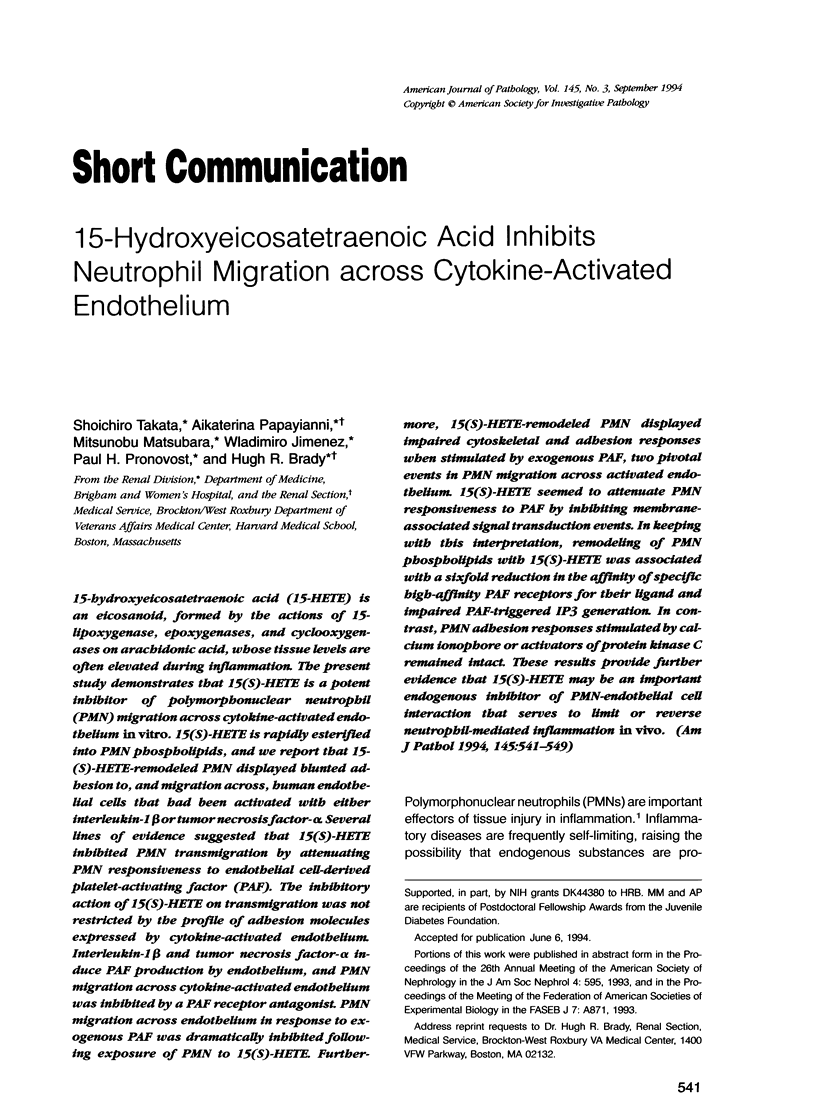
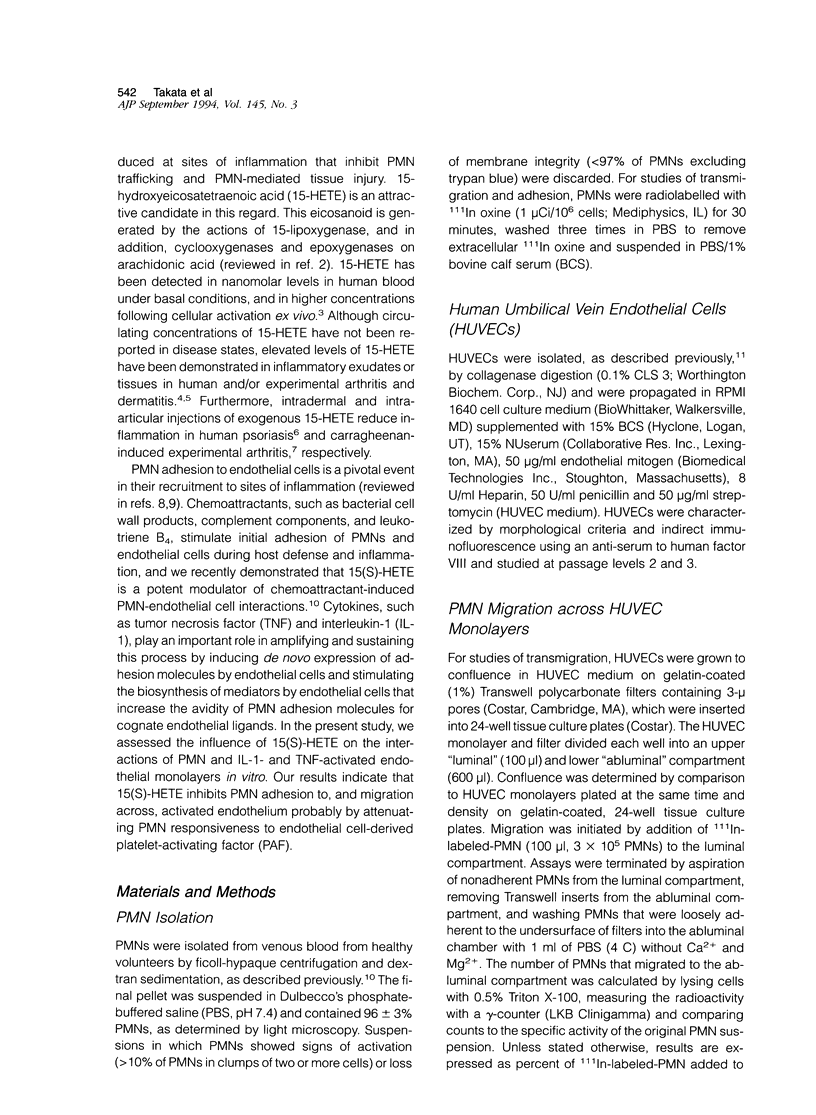
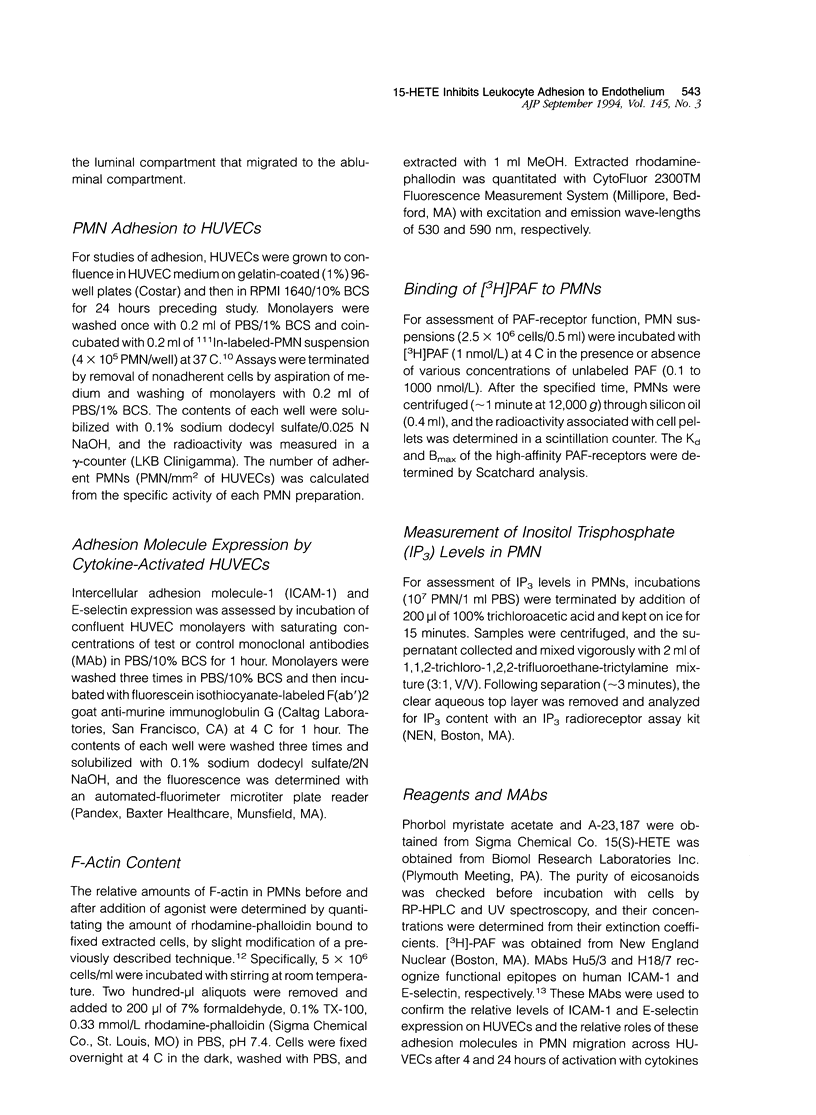
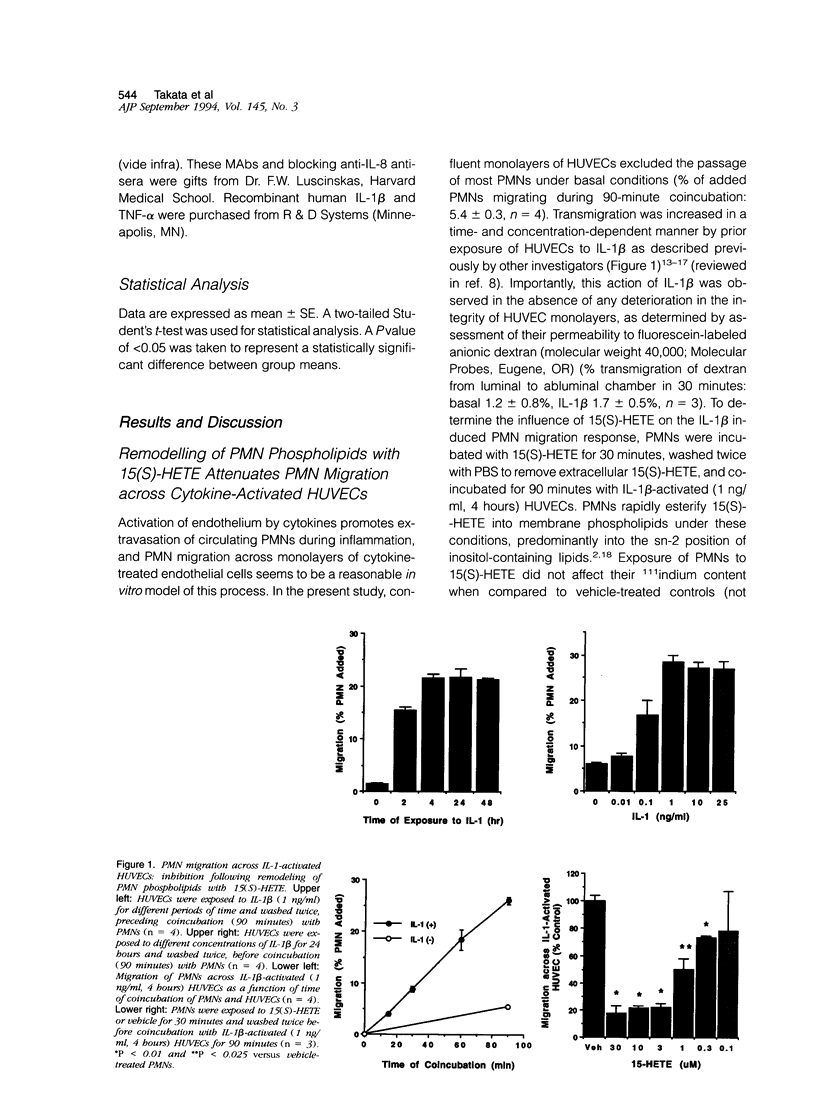
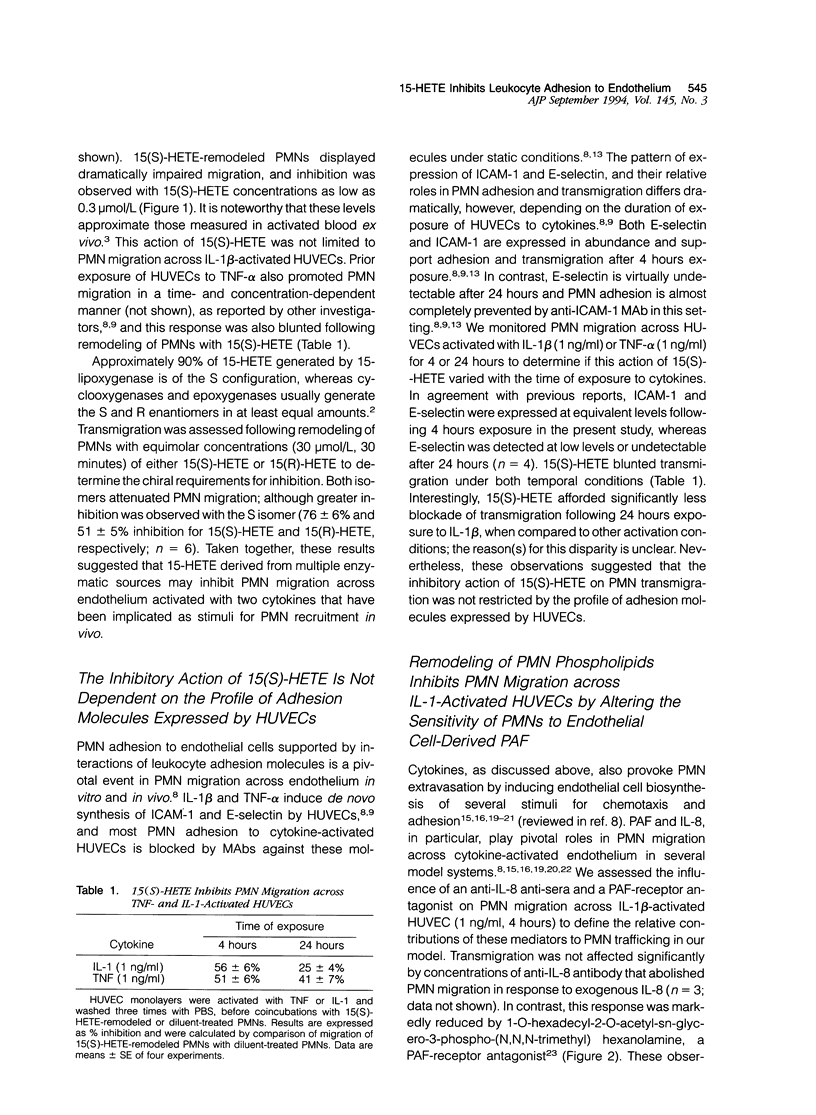
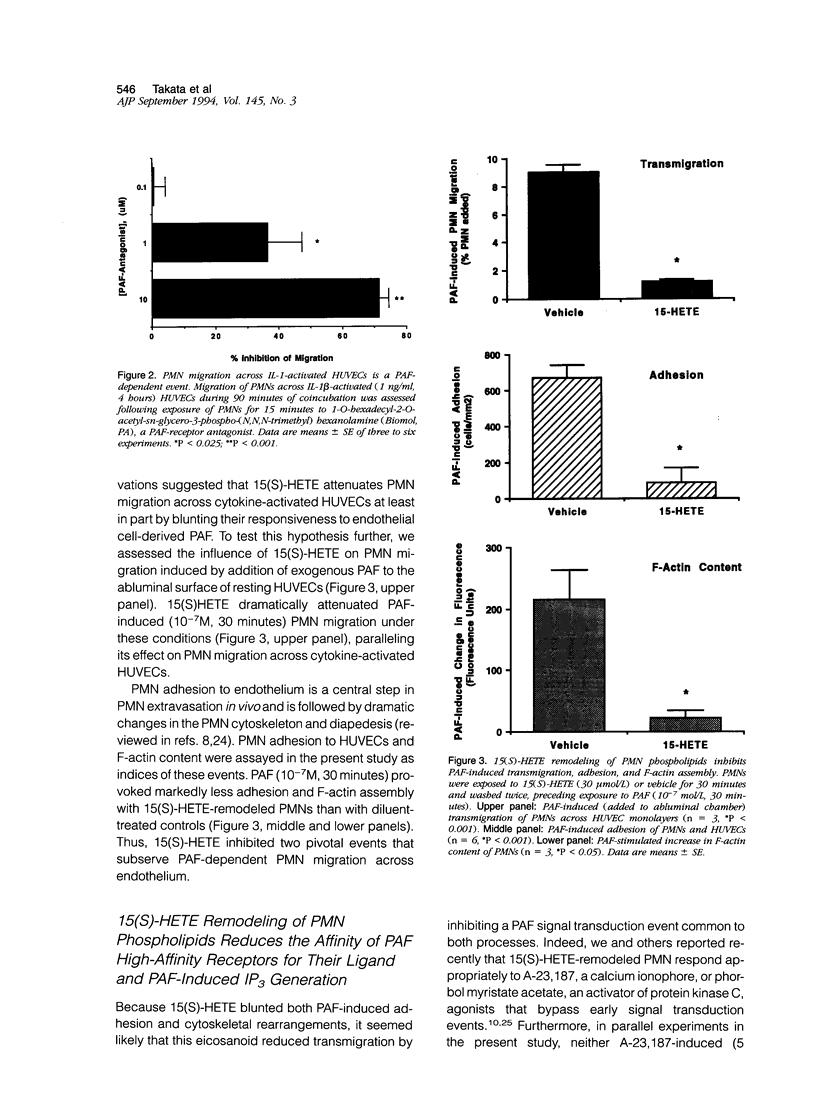
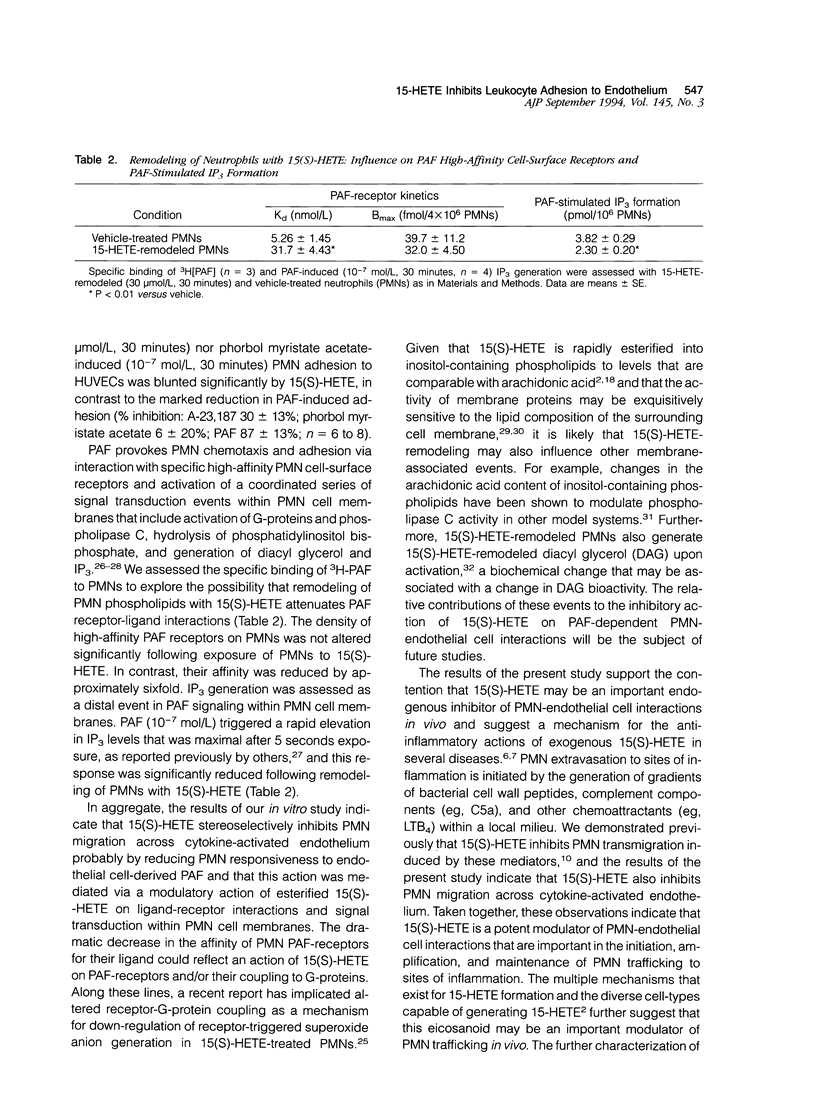
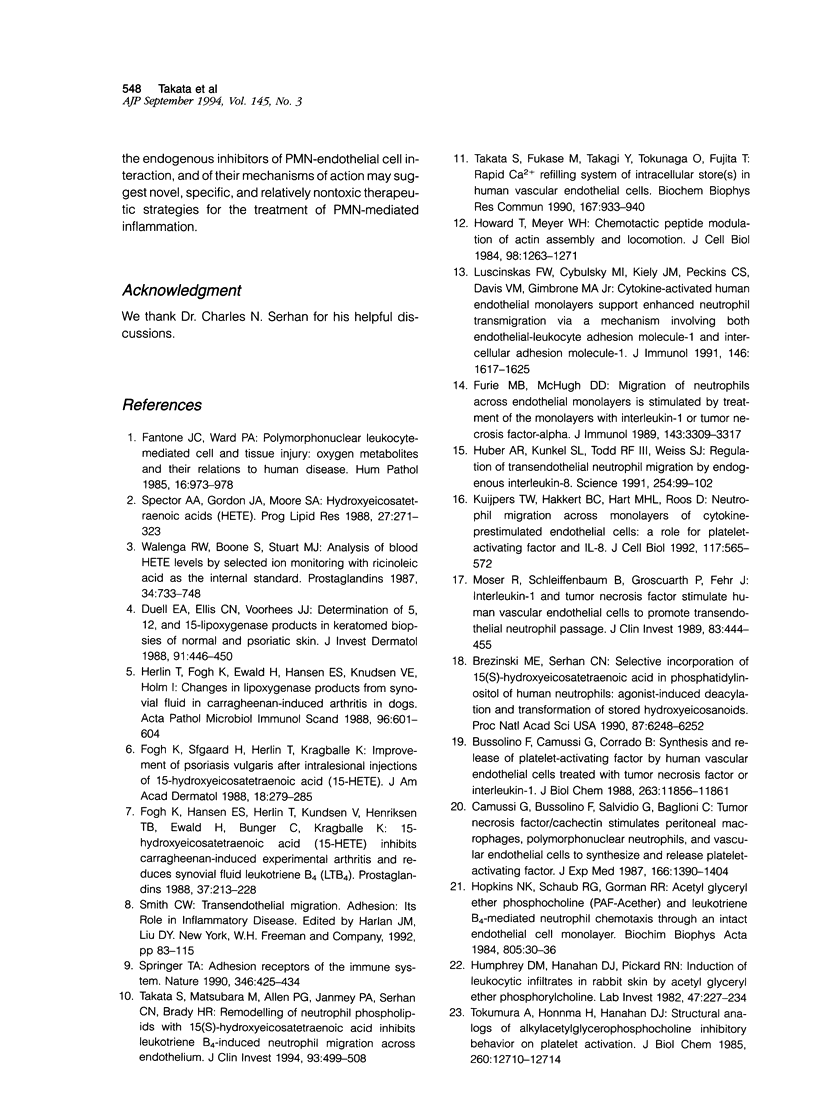
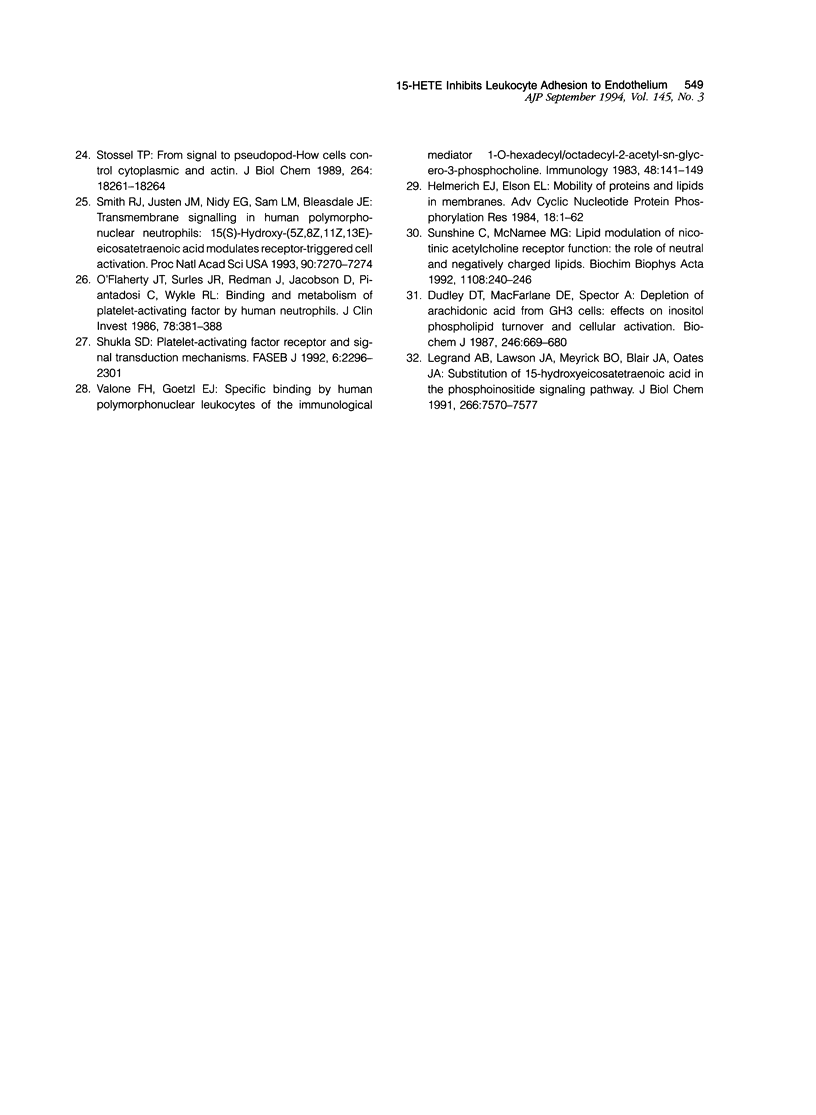
Selected References
These references are in PubMed. This may not be the complete list of references from this article.
- Brezinski M. E., Serhan C. N. Selective incorporation of (15S)-hydroxyeicosatetraenoic acid in phosphatidylinositol of human neutrophils: agonist-induced deacylation and transformation of stored hydroxyeicosanoids. Proc Natl Acad Sci U S A. 1990 Aug;87(16):6248–6252. doi: 10.1073/pnas.87.16.6248. [DOI] [PMC free article] [PubMed] [Google Scholar]
- Bussolino F., Camussi G., Baglioni C. Synthesis and release of platelet-activating factor by human vascular endothelial cells treated with tumor necrosis factor or interleukin 1 alpha. J Biol Chem. 1988 Aug 25;263(24):11856–11861. [PubMed] [Google Scholar]
- Camussi G., Bussolino F., Salvidio G., Baglioni C. Tumor necrosis factor/cachectin stimulates peritoneal macrophages, polymorphonuclear neutrophils, and vascular endothelial cells to synthesize and release platelet-activating factor. J Exp Med. 1987 Nov 1;166(5):1390–1404. doi: 10.1084/jem.166.5.1390. [DOI] [PMC free article] [PubMed] [Google Scholar]
- Dudley D. T., Macfarlane D. E., Spector A. A. Depletion of arachidonic acid from GH3 cells. Effects on inositol phospholipid turnover and cellular activation. Biochem J. 1987 Sep 15;246(3):669–679. doi: 10.1042/bj2460669. [DOI] [PMC free article] [PubMed] [Google Scholar]
- Duell E. A., Ellis C. N., Voorhees J. J. Determination of 5,12, and 15-lipoxygenase products in keratomed biopsies of normal and psoriatic skin. J Invest Dermatol. 1988 Nov;91(5):446–450. doi: 10.1111/1523-1747.ep12476562. [DOI] [PubMed] [Google Scholar]
- Fantone J. C., Ward P. A. Polymorphonuclear leukocyte-mediated cell and tissue injury: oxygen metabolites and their relations to human disease. Hum Pathol. 1985 Oct;16(10):973–978. doi: 10.1016/s0046-8177(85)80273-2. [DOI] [PubMed] [Google Scholar]
- Fogh K., Hansen E. S., Herlin T., Knudsen V., Henriksen T. B., Ewald H., Bünger C., Kragballe K. 15-Hydroxy-eicosatetraenoic acid (15-HETE) inhibits carrageenan-induced experimental arthritis and reduces synovial fluid leukotriene B4 (LTB4). Prostaglandins. 1989 Feb;37(2):213–228. doi: 10.1016/0090-6980(89)90058-0. [DOI] [PubMed] [Google Scholar]
- Fogh K., Søgaard H., Herlin T., Kragballe K. Improvement of psoriasis vulgaris after intralesional injections of 15-hydroxyeicosatetraenoic acid (15-HETE). J Am Acad Dermatol. 1988 Feb;18(2 Pt 1):279–285. doi: 10.1016/s0190-9622(88)70040-7. [DOI] [PubMed] [Google Scholar]
- Furie M. B., McHugh D. D. Migration of neutrophils across endothelial monolayers is stimulated by treatment of the monolayers with interleukin-1 or tumor necrosis factor-alpha. J Immunol. 1989 Nov 15;143(10):3309–3317. [PubMed] [Google Scholar]
- Helmreich E. J., Elson E. L. Mobility of proteins and lipids in membranes. Adv Cyclic Nucleotide Protein Phosphorylation Res. 1984;18:1–62. [PubMed] [Google Scholar]
- Herlin T., Fogh K., Ewald H., Hansen E. S., Knudsen V. E., Holm I., Kragballe K., Bunger C. Changes in lipoxygenase products from synovial fluid in carrageenan induced arthritis in dogs. APMIS. 1988 Jul;96(7):601–604. doi: 10.1111/j.1699-0463.1988.tb00917.x. [DOI] [PubMed] [Google Scholar]
- Hopkins N. K., Schaub R. G., Gorman R. R. Acetyl glyceryl ether phosphorylcholine (PAF-acether) and leukotriene B4-mediated neutrophil chemotaxis through an intact endothelial cell monolayer. Biochim Biophys Acta. 1984 Sep 14;805(1):30–36. doi: 10.1016/0167-4889(84)90033-8. [DOI] [PubMed] [Google Scholar]
- Howard T. H., Meyer W. H. Chemotactic peptide modulation of actin assembly and locomotion in neutrophils. J Cell Biol. 1984 Apr;98(4):1265–1271. doi: 10.1083/jcb.98.4.1265. [DOI] [PMC free article] [PubMed] [Google Scholar]
- Huber A. R., Kunkel S. L., Todd R. F., 3rd, Weiss S. J. Regulation of transendothelial neutrophil migration by endogenous interleukin-8. Science. 1991 Oct 4;254(5028):99–102. doi: 10.1126/science.1718038. [DOI] [PubMed] [Google Scholar]
- Humphrey D. M., Hanahan D. J., Pinckard R. N. Induction of leukocytic infiltrates in rabbit skin by acetyl glyceryl ether phosphorylcholine. Lab Invest. 1982 Sep;47(3):227–234. [PubMed] [Google Scholar]
- Kuijpers T. W., Hakkert B. C., Hart M. H., Roos D. Neutrophil migration across monolayers of cytokine-prestimulated endothelial cells: a role for platelet-activating factor and IL-8. J Cell Biol. 1992 May;117(3):565–572. doi: 10.1083/jcb.117.3.565. [DOI] [PMC free article] [PubMed] [Google Scholar]
- Legrand A. B., Lawson J. A., Meyrick B. O., Blair I. A., Oates J. A. Substitution of 15-hydroxyeicosatetraenoic acid in the phosphoinositide signaling pathway. J Biol Chem. 1991 Apr 25;266(12):7570–7577. [PubMed] [Google Scholar]
- Luscinskas F. W., Cybulsky M. I., Kiely J. M., Peckins C. S., Davis V. M., Gimbrone M. A., Jr Cytokine-activated human endothelial monolayers support enhanced neutrophil transmigration via a mechanism involving both endothelial-leukocyte adhesion molecule-1 and intercellular adhesion molecule-1. J Immunol. 1991 Mar 1;146(5):1617–1625. [PubMed] [Google Scholar]
- Moser R., Schleiffenbaum B., Groscurth P., Fehr J. Interleukin 1 and tumor necrosis factor stimulate human vascular endothelial cells to promote transendothelial neutrophil passage. J Clin Invest. 1989 Feb;83(2):444–455. doi: 10.1172/JCI113903. [DOI] [PMC free article] [PubMed] [Google Scholar]
- O'Flaherty J. T., Surles J. R., Redman J., Jacobson D., Piantadosi C., Wykle R. L. Binding and metabolism of platelet-activating factor by human neutrophils. J Clin Invest. 1986 Aug;78(2):381–388. doi: 10.1172/JCI112588. [DOI] [PMC free article] [PubMed] [Google Scholar]
- Shukla S. D. Platelet-activating factor receptor and signal transduction mechanisms. FASEB J. 1992 Mar;6(6):2296–2301. doi: 10.1096/fasebj.6.6.1312046. [DOI] [PubMed] [Google Scholar]
- Smith R. J., Justen J. M., Nidy E. G., Sam L. M., Bleasdale J. E. Transmembrane signaling in human polymorphonuclear neutrophils: 15(S)-hydroxy-(5Z,8Z,11Z,13E)-eicosatetraenoic acid modulates receptor agonist-triggered cell activation. Proc Natl Acad Sci U S A. 1993 Aug 1;90(15):7270–7274. doi: 10.1073/pnas.90.15.7270. [DOI] [PMC free article] [PubMed] [Google Scholar]
- Spector A. A., Gordon J. A., Moore S. A. Hydroxyeicosatetraenoic acids (HETEs). Prog Lipid Res. 1988;27(4):271–323. doi: 10.1016/0163-7827(88)90009-4. [DOI] [PubMed] [Google Scholar]
- Springer T. A. Adhesion receptors of the immune system. Nature. 1990 Aug 2;346(6283):425–434. doi: 10.1038/346425a0. [DOI] [PubMed] [Google Scholar]
- Stossel T. P. From signal to pseudopod. How cells control cytoplasmic actin assembly. J Biol Chem. 1989 Nov 5;264(31):18261–18264. [PubMed] [Google Scholar]
- Sunshine C., McNamee M. G. Lipid modulation of nicotinic acetylcholine receptor function: the role of neutral and negatively charged lipids. Biochim Biophys Acta. 1992 Jul 27;1108(2):240–246. doi: 10.1016/0005-2736(92)90031-g. [DOI] [PubMed] [Google Scholar]
- Takata S., Fukase M., Takagi Y., Tokunaga O., Fujita T. Rapid Ca2+ refilling system of intracellular store(s) in human vascular endothelial cells. Biochem Biophys Res Commun. 1990 Mar 30;167(3):933–940. doi: 10.1016/0006-291x(90)90613-r. [DOI] [PubMed] [Google Scholar]
- Takata S., Matsubara M., Allen P. G., Janmey P. A., Serhan C. N., Brady H. R. Remodeling of neutrophil phospholipids with 15(S)-hydroxyeicosatetraenoic acid inhibits leukotriene B4-induced neutrophil migration across endothelium. J Clin Invest. 1994 Feb;93(2):499–508. doi: 10.1172/JCI116999. [DOI] [PMC free article] [PubMed] [Google Scholar]
- Tokumura A., Homma H., Hanahan D. J. Structural analogs of alkylacetylglycerophosphocholine inhibitory behavior on platelet activation. J Biol Chem. 1985 Oct 15;260(23):12710–12714. [PubMed] [Google Scholar]
- Valone F. H., Goetzl E. J. Specific binding by human polymorphonuclear leucocytes of the immunological mediator 1-O-hexadecyl/octadecyl-2-acetyl-sn-glycero-3-phosphorylcholine. Immunology. 1983 Jan;48(1):141–149. [PMC free article] [PubMed] [Google Scholar]
- Walenga R. W., Boone S., Stuart M. J. Analysis of blood HETE levels by selected ion monitoring with ricinoleic acid as the internal standard. Prostaglandins. 1987 Nov;34(5):733–748. doi: 10.1016/0090-6980(87)90296-6. [DOI] [PubMed] [Google Scholar]


